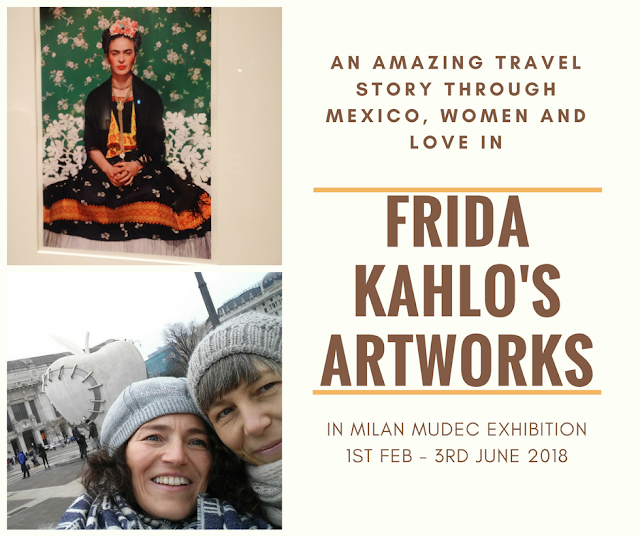AN AMAZING TRAVEL STORY ABOUT MEXICO, WOMEN AND LOVE THROUGH FRIDA KAHLO'S EYES AND ARTWORKS IN MILAN AT MUDEC
MUDEC'S FRIDA KAHLO EXHIBITION IN MILAN
"Frida Kahlo. Beyond the myth" exhibition was such a tempting opportunity to travel to Milan for the weekend: my sister Francesca and I just jumped on the first train from Venice to visit the iconic Mexican painter's exhibition which is on from 1st February 2018 until 3rd June 2018.
I had been to Mexico city last year for an overnight transit stopover on my way to another destination; however, unfortunately I was in a rush and I did not have the time to explore the interesting blu-cobalt Frida Kahlos' museum, the Casa Azul (the Blue House), her birthplace.
Therefore the Milan exhibition seemed the perfect chance to get to know more in depth this genial artist who has always fascinated me as a woman and as an ecletic painter.
MUDEC: THE IDEAL VENUE FOR FRIDA KAHLO'S ART WORKS
 |
| The MUDEC curved dome with opaque windows |
The MUDEC is located in the former Ansaldo metal carpentry works in the southern part of the city: the architect David Chipperfield has shaped and designed the museum around the idea of a covered square illuminated by natural light.
The stunning curved dome with opaque windows has become a multidisciplinary hub to display the cultural variety in the world through arts. Therefore, it is the perfect venue to showcase different world artists.
 |
| MUDEC is a hub to showcase the world through arts |
Frida Kahlo fits this place perfectly as she embodies commitment to diversity in all its forms: her look, face, clothes, relationships, thoughts, passions and vision of life.
In this post I have written an (almost) A to Z guide about Frida Kaho's paintings and most significant details of her life displayed in the exhibition.
PLAN YOUR VISIT
HOW TO REACH MUDEC, OPENING HOURS AND TICKETS
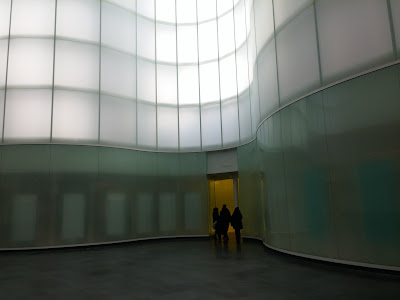 |
| MUDEC central square illuminated by natural light |
The closest metro stop is MM2 Porta Genova; then you take Via Tortona and walk for 10 minutes.
Opening hours (last admission one hour before closing):
Mo 14.30 - 19-30
Tue-We 9.30-19.30
Thu - Fri - SA: 9.30 - 22.30
Su 9.30 - 20.30
Admission ticket: 13 euros (reduced price are availabel. Please click here.)
AN (ALMOST) A TO Z GUIDE ON FRIDA KAHLO
A IS FOR ... ACCIDENT
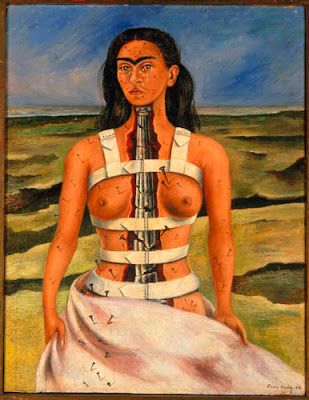 |
| Frida Kahlo's The broken column: this is how she saw herself after the accident |
Unfortunately, the second bus that she caught was involved in a serious accident with a tram, and she reported several injuries, including her spine, legs, feet and shoulders. She had to be operated more than 30 times! Being bedridden and unable to move for a long time, she started to paint in bed with a special easel.
B IS FOR ... BODY
Most of Frida Kahlo's artworks are paintings about herself and her figure. Some commentators dismiss this as an earlier example of selfie, which to me is a simplistic view of this woman in distress: the process of painting her image was a forced one, as she had to spend months in bed with a mirror hanging over her to draw.
"I don't paint dreams or nightmares, I paint my own reality", she declared: she had to learn how to deal with and endure all her surgical operations, body pain and loneliness.
Her fixation for her body is clear from the dozen images of her spine replaced by a Roman column, or nails sticking out of her skin, or her body pierced by a crown of spines.
Her self-portraits include depictions of everything about her physical aspect: her own birth, miscarriges and the turbulent marriage with Diego Riviera whom she often tattooed on her body in her canvasses.
I must say that some of her fine artworks are quite unsettling, or at least for me they were. You can rest assured: you will almost feel her pain as you walk thorugh the rooms, and you won't leave the place without feeling uneasy.
C IS FOR ... CASA AZUL
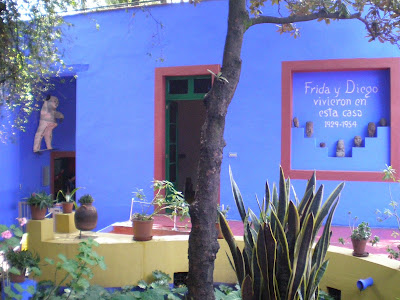 |
| Casa Azul - Frida Kahlo's museum in Mexico @Eclusette |
D IS FOR ... DIEGO RIVERA
 |
| Diego Rivera was a famous artist and Frida Kahlo's husband |
Frida Kahlo and Diego Rivera had the most unconventional and tormented relationship that might think of. When they met, she was still an art student aged 21, while he was 42. He was already one of the most famous and rich painters on the Mexican scene.
He had studied at the Art Acamedy in Mexico, lived in Paris and in Italy, and befriended art masters, such as Amedeo Modigliani. He become popular in Mexico for his murals which showed the Mexican peasants' and working classes' harsh conditions.
Despite the fact that he supported the Communist Party and in 1937 hosted the Trotsky's in the Casa Azul, he had powerful connections with the Rockfeller family. In 1933 The Rockfeller's commissioned Diego the murals for the Rockfeller Centre in New York which were later destroyed since Diego had drawn Lenin on them!
That's why it not possible to talk about Frieda and Diego's relationship without talking about their joint interests for art and politics, their common views and thoughts.
"The elephant and the dove" - as talebearers described the couple - got married twice: in 1929, and again in 1939 (after a short divorce); however, together with their common interests, they also shared infidelities and cheating on each other.
Diego was so important for Frida that she would paint canvases with Diego on her forehead. Frida was a woman full of contradictions: she had an obsessive love for her husband, and was embittered by Diego's betrayals. However, she was unfaithful to him too (allegedly with both men and women).
"There have been two accidents in my life. One was the trolley and the other was Diego. Diego was by far the worst", she declared once.
F IS FOR ... FACE
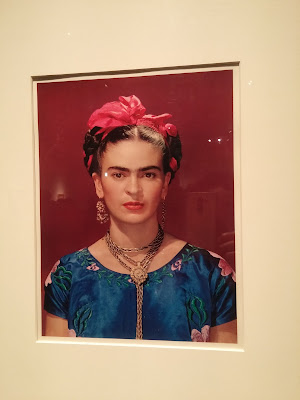 |
| Frida Kahlo's iconic face with her unibrow and moustaches |
Frida Khalo's face is so iconic that even those who don't know anything about her, know whom that face belongs to! Her thick black unibrow and her black moustaches that she would sometimes blacken more tell a long story about her.
She was very conscious of her femininity and sexuality: she challenged any taboo or beauty stereotypes fearlessly by showing off her pitch black brows as in old Aztec customs. Moreover, her moustache was worn as a sign of her strong masculine side.
Her proud look and her deep eyes really strike you every time you look at her canvasses. It is as if she told you: "This is who I am, whether you like it or not. What you see is what you get. You should hold your head up high too".
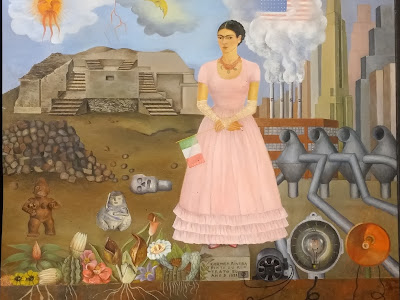 |
| Self-portrait along the border line between Mexico and the USA; her past heritage is in all Frida's paintings |
Frida's father Guillermo was born in Germany in the town of Pforzheim in southeastern part. He played an important role in her life because he encouraged her to follow her interests. He was also a professional photographer so he taught her the correct use of light.
Her mother, Matilde Calderón, was a Mexican of Spanish origins: this hybrid mix of German-European and Mexican roots in her family heritage was a leitmotiv of Frida's work whose paintings show symbols of various cultures.
H IS FOR ... HAIR
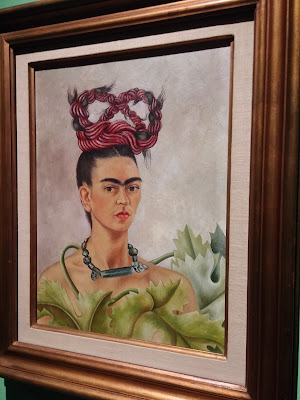 |
| Self portrait with braid: one of the key features in her canvasses is her hair style |
Frida's hair is also a key element in her paintings. One of the most beautiful and powerful photos on show is Frida sitting on a chair, wearing a manly tunic and trousers. She is wearing her hair loose and smooking a cigarette.
Wearing untied hair was uncommon for her as she loved Mexican traditions which implied fanciful hair styles. In almost all of her paintings she is wearing floral crowns, braids, buns in the old Aztec style, together with traditional clothes.
However, her style was always personal: when Diego cheated on her for the umpteenth time, she painted her self-portrait wearing really short hair and man's clothes.
When I came out of the exhibition my sister and I discussed a lot over the fact that she is still a modern symbol and, as the marketers put it, she has a strong personal brand.
She was audacious: for a Mexican woman, no matter how famous, her bold attitude was unthinkable at that time. When she was young, Frida wanted to become a doctor, and her I-do-things-my-own-way attitude was what attracted international attention towards her, and that's why she gained so much respect in the world.
However, I left Milan with another message from Frida, much stronger to me than the previous one: through pain and hardships, stay strong, live your life with passion without backing off and hiding. In a few words: be yourself in good and bad times.
L IS FOR ... LEGS
 |
| Frida wore long clothes to hide her leg impairments and keep Mexican traditions alive |
Nevertheless, her father encouraged her to play all sports. This attitude spoke volumes about her iron will. However, you can see that in most paintings and in photos she is wearing long clothes to cover her impaired legs and her prosthesis.
M IS FOR ... MEXICO
 |
| She used to wear Tehuana traditional clothes with a strong emphasis on Mexican native culture |
Tehuantepec municipality where Tehuana women live is located in the southeast state of Oaxaca; the special thing about this area is that women wear colourful garments and perpetuate a matriarchal society, as well as being very indipendent.
Kahlo drew solidly on the Mexican culture: she wore their embroidered dresses (huipiles, in Spanish) with she matched with fashionable cat-shaped glasses or red boots.
By wearing the same clothes and being inspired by their indipendent frame of mind, she empowered women to defy any unfortunate destiny and take responsibility for their life.
The amazing fact is that only in 2002, 50 years after her death, did the world discover more about her beautiful Mexican attires: first Frida, and then Diego had requested to keep all her personal belongings under lock and key in the Casa Azul.
O IS FOR ... OBSESSION
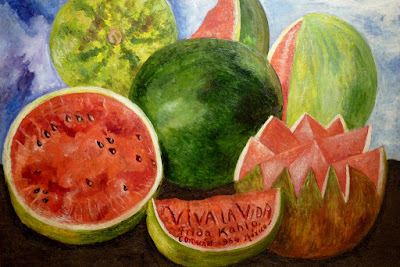 |
| Frida's obession was life in the end |
P IS FOR ... PASSION
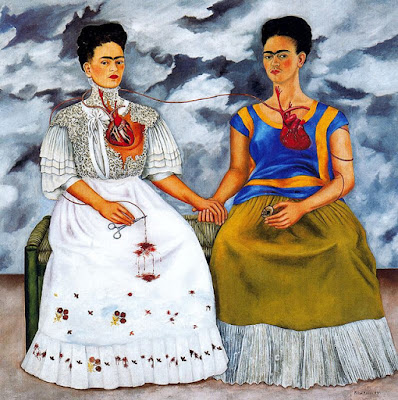 |
| The two Fridas: she had a very passionate love life |
On top of Diego's tormented relationshio, she is said to have loved both men and women with whom she was involved with passion.
The words she wrote in a letter illustrate how passionate she was:
"You deserve a lover who wants you disheveled, with everything and all the reasons that you wake you up in a haste and demons that won't let you sleep.
You deserve a lover who makes you feel safe, who can consume this world whole if he walks hand in hand with you; someone who believes that his embrace are a perfect match with your skin.
You deserve a lover who wants to dance with you, who goes to paradise every time he looks into your eyes and nver gets tired of studying your expressions.
You deserve a lover who listens when you sing, who supports you when you feel shame and respects your freedom; who flies with you and isn't afraid to fall.
You deserve a lover who takes away the lies and brings you hope, coffee and poetry".
S IS FOR ... SUFFERING
 |
| Self-portrait with thorn necklace: her body and emotional pain come out of every paintings |
Frida suffered emotionally as well as physically since she was a child. After the birth of her younger sister, her mother decided to entrust her to a wet nurse and Frida suffered a lot as if her mother had rejected her.
Moreover, she did not have any children because of her impairment and would often paint herself either holding Diego as a child, or being held in someone else's arms as a baby.
However, her unwavering stamina and vital force made her write: "At the end of the day, we can endure much more than we think we can".
Z IS FOR ... ZERO CENSORSHIP
 |
| Self-portrait with cropped hair: Frida dealt with a range of taboos |
Frida Kahlo's paintings bring up a wide range of themes that were considered by far taboos, such as death, pain, body scars, and loneliness. She did not restrain herself: through her canvasses she created a sort of personal diary in which she was able to project her fears and her human condition.
However, she did not want to give in to her silent pain and to us she is joy personified. Despite her problems, she did not miss the chance to offer dinners to her friends, drank and smoked a lot.
At the end of the exhibition the feeling was that I hadn't quite grasped the full complex nature of Frida as a woman and as an artist. What I felt was that she seemed to understand better than anyone else that living is a mystery to be fully experienced rather than understood.
Closing the museum door behind me, this is Frida's ultimate message I took with me.
 |
| Life is a mystery that you need to experience and this is her most powerful message |
